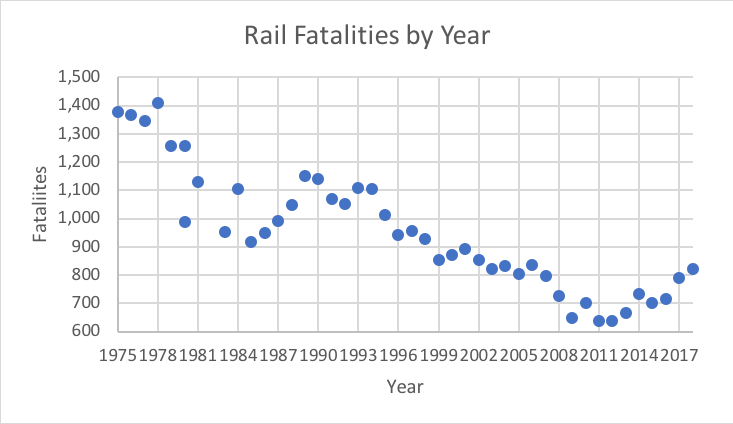At the June 20 hearing of the House Railroads Subcommittee on “The State of the Rail Workforce,” witnesses and Democratic members expressed that over the past decade, railroading has changed dramatically in this country. Most Class-I railroads have adopted or are in the process of implementing “Precision Scheduled Railroading” (PSR), which has improved railroad profitability. Several Democrats on the Subcommittee on Railroads, Pipelines, and Hazardous Materials lamented that technology cannot replace workers.
As PSR and increased automation have resulted in job cuts and trains become sometimes more than 15,000 feet long, the subject turned to the Donald Trump Administration’s recent cancelation of a proposed Barack Obama-era rule requiring two-person crews on all trains. (Some states already have such rules). The first witness at the hearing, Federal Railroad Administration (FRA) Administrator Ronald Batory, said that there was no evidence to support the safety-based need for another employee in the cockpit. Batory also brought up that the federal government only recently required freight railroads to install expensive automatic braking technology (positive train control, or PTC) on most of their routes.
Transportation and Infrastructure chairman Peter DeFazio (D-OR) asked Batory how long trains can be, to which Batory replied that there is no limit. DeFazio, referencing the absence of a federal two-man crew minimum regulation, said, “Isn’t there a point at which you’re going to be concerned about the safety, by the reduction of the number in employees and the inconvenience for the rest of the United States of America because these companies are driving these trains as long as they can with as few people as they can?”
Batory explained that he has been committed to safety throughout his railroading career, “I’ve had sincere commitment to safety since the day I was employed in the railroad industries in 1971, right up unit the day I retired. And I still carry that commitment to safety.”
He expressed concerns with commuter rail lines’ ability to fully implement positive train control with only 30% of their systems complete. With an implementation deadline looming in 15 months, Batory said, “I have a concern.” He has asked commuter rail agencies, signaling out the Northeast Corridor especially, that if they believe they are at risk of failing to meet the deadline, they should meet with their federal legislators. Batory explained, “My hands are on this, my eyes are on it. I think about it all the time, I’m on the phone all the time. I spend probably 25 to 40 percent of my time on PTC. I’m committed.”
Batory made the point that in 1978 there were 408 head-on train collisions, where most trains had four to six crew members, compared to one collision in 2018. To this end, Batory explained that safety has greatly improved despite a shrinking crew size. “Well, we certainly have incurred changes, no doubt about it. When I hired out in 1971, we had around 700,000 employees.”, said Batory.
The issue of crew size originated from the 2013 Lac-Mégantic rail disaster, where an unattended 74-car freight train carry crude oil rolled away and exploded, killing 47 people.
Not all the Democrats were impressed, Congressman Stephen Lynch (D-MA) explained, “You have huge trains. You have huge disruptions in these communities, where you have hundreds and hundreds of cars on these trains and–and you’re absolutely right. You should have two people on that train. You draft the rule. May 23rd comes, and you withdraw it. There’s plenty to support the rule.”
Later in the hearing, several witnesses offered input on the state of rail workers. Dennis Pierce, the president of the Brotherhood of Locomotive Engineers and Trainmen expressed concern that the new NAFTA replacement, the USMCA, failed to provide adequate rights for American rail workers whom are unable to work in Mexico. Under Mexican law, only Mexican nationals can work on Mexican railroads. Unless this law is changed, American rail workers remain at a disadvantage.
Pierce expressed a negative opinion about PSR, the fact that employees have sometimes as little as 90 minutes notice to report to work and the lack of a rule requiring 2 workers on every train. President of the Brotherhood of Railroad Signalmen, Jerry Boles, lamented that only 21 percent of his members who had been surveyed believed their PTC training to be sufficient.

William Gonzales, president of the Amtrak Labor Committee expressed concern to the committee in regard to cuts to the Amtrak police force. Specifically, Gonzales said that Amtrak CEO Richard Anderson wanted to reduce the Amtrak police force by 85 officers and 15 civilian employees, or another 20 percent.
Gonzales said of the staff reduction, “This reduction would result in police force staffing levels not seen since before 9/11.”
He also explained that the Amtrak police’s new 9mm handguns which were purchased to replace the three-year-old .40 caliber weapons were a wasteful purchase, along with new body cameras and TASERs. Gonzales had strong words about the corporation, “Amtrak as a corporation has simply put, been more concerned with appearances than practical law enforcement and the safety of its passengers.
By the end of the meeting, Democratic members of the subcommittee still seemed to be unsatisfied by the current state of rail workforce issues. There are no limits as to how long a train can be, there is no federal requirement for having more than one worker on a train, and PTC has still not been fully implemented on many commuter rail lines. The position of the FRA and Ian Jefferies, the president and CEO of the Association of American Railroads, is that despite a shrinking work force, American railroads have never been safer, more efficient and ready for the future.


FRA data from 1975 to 2018 shows that rail fatalities, including trespasser deaths, are down significantly, from a high of 1,408 deaths in 1978, to a low of 636 in 2012. However, in the last few years deaths have been increasing mainly due to trespassing. While most of the deaths come from trespassers, several deaths each year, sometimes over 100 people in the 1970’s, involve employees or contractors. However, it is important to note that many of the railroad deaths were suicides, and besides self-inflicted death, mortality rates have been on a downward trend.
Earlier in the hearing, Batory explained, “We have seen great advances in railroad safety, both the train accident rate and railroad employee injury rate have declined. Despite these advances, rail accidents and employee injuries do occur. FRA considers one accident or one employee injury one too many.”
Grade crossing accidents continue to be a large cause of railway fatalities, Batory explained that, “even though grade crossing accidents would… fluctuate, but they were saw tooth, but they were low, the trespasser just keeps growing and growing and growing. And we have a problem, and initially, we have to address in this society.”






